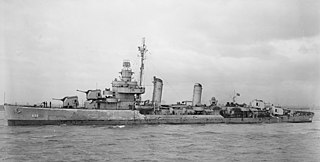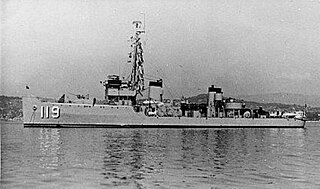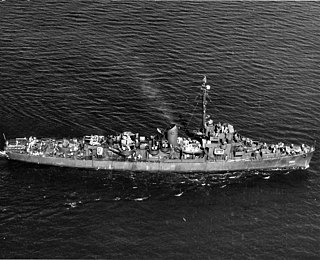
USS Cole (DD-155) was a Wickes-class destroyer in the United States Navy during World War II, later reclassified as AG-116. It was named for Edward B. Cole, a United States Marine Corps officer who died as a result of the wounds he received at the Battle of Belleau Wood.

USS Dickerson (DD-157) was a Wickes-class destroyer in the United States Navy, and was converted to a high-speed transport at Charleston, South Carolina and designated APD-21 in 1943. She was named for Mahlon Dickerson (1770–1853), Secretary of the Navy from 1834 to 1838.

USS Herbert (DD-160) was a Wickes-class destroyer. She was named for Hilary A. Herbert (1834–1919), Secretary of the Navy from 1893 to 1897.

The second USS Buck (DD-420), a World War II-era Sims-class destroyer in the service of the United States Navy, was named after Quartermaster James Buck, a Civil War Medal of Honor recipient. It was built by Philadelphia Naval Shipyard and launched in 1939. It was a member of the convoy carrying the US 1st Provisional Marine Brigade. She served during the Second World War. It was sunk by the German submarine U-616 on 9 October 1943 off the coast of Salerno, when it was working in support of Operation Avalanche. It received 3 battle stars for its services during the Second World War.

USS Ludlow (DD-438), a Gleaves-class destroyer, was the third ship of the United States Navy to bear the name. The second and third Ludlow ships were named for Lieutenant Augustus C. Ludlow, second in command of USS Chesapeake. He was, like his captain, mortally wounded in their ship's engagement with HMS Shannon on 1 June 1813, and died at Halifax, Nova Scotia on 13 June.

USS Edison (DD-439), a Gleaves-class destroyer, was the first ship of the United States Navy to be named for Thomas Alva Edison, an inventor and businessman who developed many important devices and received the Navy Distinguished Service Medal for his contributions to the Navy during World War I. Edison was one of the few U.S. Navy ships to be named for a civilian.

USS Eberle (DD-430) was a Gleaves-class destroyer of the United States Navy. The ship is named for Rear Admiral Edward Walter Eberle, who commanded the Atlantic and Pacific Fleets and was Chief of Naval Operations from 1923 to 1927. The destroyer entered service in 1940 and spent the majority of her career in the Atlantic Ocean. Placed in reserve following the war, the ship was transferred to the Hellenic Navy in 1951. Renamed Niki, the destroyer remained in service until 1972 when she was scrapped.

USS Niblack (DD-424), a Gleaves-class destroyer, is the only ship of the United States Navy to be named for Albert Parker Niblack. Niblack became the Director of Naval Intelligence 1 March 1919, and Naval Attache in London 6 August 1920. As Vice Admiral, he commanded U.S. Naval Forces in European waters 15 January 1921 to 17 June 1922.

USS Knight (DD-633), a Gleaves-class destroyer, is the only ship of the United States Navy to be named for Admiral Austin M. Knight.

USS Benson (DD-421) was the lead ship of her class of destroyers in the United States Navy during World War II. She was named for Admiral William S. Benson (1855–1932).

USS Mayo (DD-422) was a Benson-class destroyer in the United States Navy during World War II. She was named for Admiral Henry Thomas Mayo.

USS Weeden (DE-797) was a Buckley-class destroyer escort in service with the United States Navy from 1944 to 1946 and from 1950 to 1958. She was scrapped in 1969.

USS Laning (DE-159/APD-55) was a Buckley-class destroyer escort in service with the United States Navy from 1943 to 1946 and from 1951 to 1957. She was scrapped in 1975.

USS Frament (DE-677/APD-77) was a Buckley-class destroyer escort in the United States Navy.

USS Speed (AM-116) was an Auk-class minesweeper acquired by the United States Navy for the dangerous task of removing mines from minefields laid in the water to prevent ships from passing.

USS Sustain (AM-119) was an Auk-class minesweeper acquired by the United States Navy for the dangerous task of removing mines from minefields laid in the water to prevent ships from passing.

USS Thornhill (DE-195) was a Cannon-class destroyer escort in service with the United States Navy from 1943 to 1947. In 1951, the ship was transferred to the Italian Marina Militare and renamed Aldebaran. The ship remained in service until 1976 when she was sold for scrap.

USS Rhodes (DE-384) was an Edsall-class destroyer escort in service with the United States Navy from 1944 to 1946 and from 1955 to 1963. She was scrapped in 1975.

USS Maurice J. Manuel (DE-351) was a John C. Butler-class destroyer escort acquired by the U.S. Navy during World War II. The primary purpose of the destroyer escort was to escort and protect ships in convoy, in addition to other tasks as assigned, such as patrol or radar picket.
USS Johnnie Hutchins (DE-360) was a John C. Butler-class destroyer escort acquired by the U.S. Navy during World War II. The primary purpose of the destroyer escort was to escort and protect ships in convoy, in addition to other tasks as assigned, such as patrol or radar picket. She served in the Pacific Ocean, and, post-war, she returned home with a Navy Unit Commendation awarded to her for her battle with Japanese midget submarines on 9 August 1945.



















